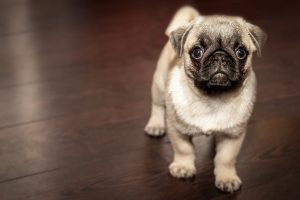
Potty training a puppy is a sometimes messy, but ultimately rewarding process. And with a little know-how and a regular potty routine, you'll be able to get your pup on the right track and keep both your pup and your home happy, comfortable, and clean.
So let's look at the ins and outs of how to potty train a puppy: creating a proper potty training routine, setting a potty schedule, and reacting when the inevitable accident occurs.
How to Potty Train a Puppy: The Fundamentals
Helping your puppy develop trustworthy potty behavior is a crucial part of taking in a new fluffy family member. And it's best to start as soon as possible so that you can establish good behavior early on.
Always remember that your new puppy will come to you completely ignorant of the rules and proper protocol of the house. You're teaching behavioral guidelines from the ground up. It's your job to teach your pup where and when mealtimes happen, where and when bedtime and playtime happens, and, of course, where and when to go to potty. So don't be surprised (or angry!) if the first thing your pup tries to do when it comes home is urinate on the carpet—your pup just doesn't know the lay of the land yet.
To teach your new puppy the rules of the house, you'll want to give plenty of guided opportunities for the behavior you want to see and also interrupt and redirect any unwanted behavior. Applying this to potty habits, you'll need to guide and provide your dog with opportunities to eliminate in the right places and interrupt unwanted elimination whenever you see it.
Though accidents will happen, proper potty training is about minimizing them whenever possible. So not only should you give opportunities for your dog to perform the desired behavior (in this case pottying in the right places), but reasons for your dog to do so.
Dogs repeat behaviors that have rewarded them in the past, and they develop routines just like people do. Your job is to make pottying in the right place more rewarding to your dog than pottying in undesirable locations. If they get rewards for going where you want them to go and nothing for doing it anywhere else, then they're going to keep pottying in the "right" places so they can keep those rewards coming!
Now that we've covered the basics, let's go into more depth about exactly how to potty train a dog.
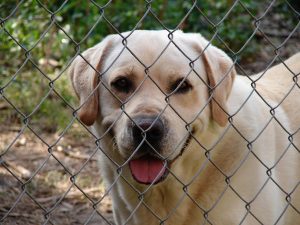
#1: Prepare Your Home for Potty Training a Puppy
Before you even bring your new puppy home, there are a few things you'll need to purchase to make potty training go as smoothly as possible.
When it comes to house training you'll need three things for your new pup: containment, a designated bathroom area, and a reward.
Containment
Dogs are naturally averse to soiling their den-space. Ultimately, your goal is to teach your dog that the whole house is you and your pup's extra large den.
To start this process, keep your puppy contained indoors or in your direct line of sight at all times. You'll need to restrict your puppy's free movement around the house so that you can prevent any accidents from occurring (and any bad habits from forming). As your dog gets older and more trustworthy, you can extend this free play time until your dog is free to roam the house most of the time.
Containment can be a dog crate, a baby gate to contain the puppy in a particular room or area, or a puppy den/playpen. You might even use multiple types of containment depending on the time of day. For example, you may use a crate at night during bedtime and a puppy playpen during the day.
As long as the space is limited and your puppy spends a good deal of time there, your pup will start to feel like that space is their den area. The more at home your pup feels in a space, the more reluctant they'll be to soil it.
Bathroom Area
You're really teaching your pup two different concepts when you potty train them: where to go to the bathroom, and where not to go to the bathroom. Teaching your dog where to go to the bathroom is much simpler than teaching them the ten thousand places not to go.
Your dog will start to understand where to go potty if you take your pup to the same spot for every potty break. If you're using a wee mat, then always keep the mat in the same place and bring your puppy there for each bathroom break. If you're teaching your pup to go potty outside, always bring your pup (on a leash!) to the same spot each and every time.
Wherever you choose to take them, this will soon become their "bathroom spot." And they'll soon learn that it's time to go potty whenever you lead them there.
Reward
Nothing says "job well done" better than a reward! For potty training purposes, praise, treats, and gentle pats act as rewards of good elimination behavior.
In the first few weeks of house training, try to give your pup both praise and a dog treat for every successful elimination. As your pup gets older and more used to eliminating in the right place, you can start giving treats less often. But always remember to congratulate your pup every time!
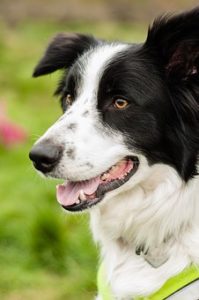
#2: Use a Cue Word to Show Your Puppy When to Potty
To help your pup know what to do during potty breaks, it's best to connect the act with a cue word or phrase. That way, your pup will learn that the cue word means it's time to go. And, eventually, you'll also be able to ask your pup to go potty on command.
The phrase or word can be anything you'd like it to be, such as "go potty" or "do your business." So long as it's a phrase you don't use in normal conversation, any phrase will work. Begin the process by saying the phrase just as your dog is starting to eliminate. (Note: say the cue gently enough that your pup doesn't get startled or distracted and stop!)
Use the cue word every single time your pup eliminates in the right spot. Once you feel that your pup has connected the cue word with the action of eliminating (usually after 2 or 3 days), begin saying the cue word just as your pup starts to get into "potty position," but before your pup starts to actually eliminate. You're shifting the phrase to cue the behavior just before it occurs. That way, your dog will learn that the cue word means it's time to eliminate.
Once you feel confident that your pup knows the cue acts as a command to eliminate (usually after a week or two of repetition), give the cue word before your pup even gets into position. Now you're signaling to your dog: "it's time to go!" even before they've thought of doing it themselves.
If your pup doesn't eliminate on cue (or make an attempt to eliminate), then take a step back in the process and try again. Eventually, they'll connect the phrase with the command to potty.
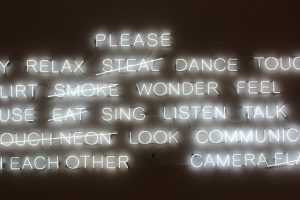
#3: Rely on Positive Reinforcement When Housebreaking a Puppy
Lets talk a little more about rewards—positive reinforcement is a major part of how to potty train a puppy. As we've mentioned, dogs will quickly learn to repeat any behavior that results in a reward, which is a technique known as "positive reinforcement." If always going to the bathroom in the proper place gets your pup a reward (and eliminating inside never does), then your pup is going to want to start pottying in the proper place.
With positive reinforcement, both consistency and timing are key. You'll want to praise and reward your pup every time you see the desired behavior, exactly when the behavior occurs. If you don't time the reward properly, your pup might believe the reward is connected to a separate behavior. For instance, if you give a reward too late, your puppy might think it's being rewarded for stopping peeing or stepping away from the potty area, rather than for eliminating in the right spot.
Because timing for positive reinforcement is so crucial, it's a good idea to connect a word or a sound with a desired behavior (and its subsequent reward). That way, your dog knows it's being rewarded for the correct behavior and not something else. For example, if you say the word "yes!" or use another consistent noise like a clicker and then always give your dog a treat, your dog will connect the sound to the reward. Then, you can use that connection between "positive noise" and "reward" during potty training.
While your dog is eliminating, use the "reward" sound to let your dog know that that particular behavior is the one that's being rewarded. That way, your pup still connects the proper behavior to the reward, even if it takes you an extra second or two to give your puppy the treat.
By combining your go-potty cue word with your positive-reward signal, your potty training routine will eventually look like this:
"Go potty!" *dog eliminates* "Yes!" *treat*
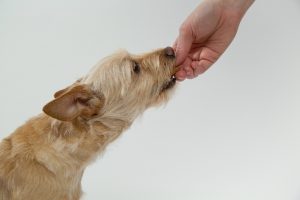
#4: Set a Potty Training Schedule
For the first few weeks, expect to take your puppy to go potty upwards of 10 to 15 times a day.
When to take your puppy to go potty:
- First thing in the morning
- Immediately after each meal
- Immediately after your pup wakes up from a nap
- Regularly throughout the day and evening (every hour to every few hours)
- Right before bed
What does it mean to take your puppy out "regularly" during the day? Begin by taking your puppy to the same designated potty area once every hour. Whether this is to a specific spot outside or to a wee mat, keep the location consistent to help acclimate your pup to going in a specific place. (Special note: avoid setting a loud timer to remind yourself to take your puppy out—your puppy will likely start associating the sound with potty time and it could lead to some accidents in the house if you're not careful!)
Always wait until your pup has eliminated before going back inside. There will be a lot of "waiting around" time for both you and your pup during the first few weeks of potty training and you'll just have to be patient. Sometimes your pup will be reluctant to pee outside or on the wee mat for any number of reasons, and you may want to give up and just go inside. But it's very common that a puppy will spend 5 or 10 minutes doing nothing outside and then come straight inside and pee on the floor (argh!). So patience is the key to success.
Eventually, your puppy will learn that eliminating in the right place (and doing so quickly!) brings a quicker reward.
For every month, increase the time between outings by an hour. So you'll go from one to two hours, then three, and four, and so on, up to a maximum time of eight hours between bathroom breaks. If you notice that your pup is having more accidents or is otherwise signaling to go outside, go back the previous schedule and reduce the time between potty trips.
As a general rule of thumb, puppies can hold their bladders for about an hour for every one month of age, up to eight hours. So a two-month-old puppy can hold its bladder for about two hours and a five-month-old puppy can hold its bladder for about five hours. No puppy (or grown dog) should be expected to hold its bladder for more than eight hours unless it's overnight.
Do take note that this rule mostly applies to medium and larger breed dogs (over 30 lbs). Small dogs simply can't hold their bladders as long as larger dogs can, and this applies extra for puppies. So if you have a small breed puppy, subtract an hour or two from the estimate. A five-month-old Chihuahua puppy, for example, can reasonably hold its bladder for three to four hours.
For the first three or four months—or even longer for smaller breeds—you'll also likely need to take your puppy outside or to the wee mat in the middle of the night or very early in the morning (think 4 or 5 AM). Small puppies just can't last the whole night without needing a bathroom break or soiling their sleeping area. So, even though it's annoying to have to get up in the middle of the night, you must do so for your pup. For the sake of your puppy (and your house) always respond promptly to your puppy's signals to go outside.
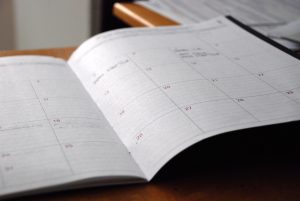
#5: Give Your Puppy Free Play Time
After your pup has eliminated in the proper place, you can allow 15 - 90 minutes of free, un-contained time (depending on how old your puppy is and how long your pup can hold its bladder). Make sure you keep your eyes on your puppy during this time to help prevent any accidents. After free time is over, invite your pup to go into the puppy den or contained area until it's time for the next potty break.
"Free play" time should be only a fraction of as long as your puppy can reasonable hold its bladder. So if your puppy can only last for an hour until the next potty break, let free play time be a maximum of 15 minutes. If your pup can last four hours, let free play time be 50 or 60 minutes. Just because your pup can last for four hours between potty breaks doesn't mean it wants to unless confined to a space it's reluctant to soil. So don't invite temptation for your pup to eliminate in the house by allowing your puppy too much free time.
Establishing a regular potty routine with your pup will help minimize accidents, as will learning how to interpret your dog's signals. It's common for dogs to circle, sniff at the ground, move to a corner of a room, whine, or scratch at doors to signal that they're about to relieve themselves or to indicate that they want to go outside. You'll have to figure out your own dog's personal signals and keep a sharp eye out.
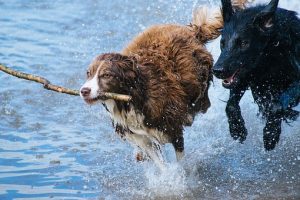
#6: Deal With House Training Accidents Calmly
Accidents will inevitably happen while house training a puppy, so don't get too discouraged. And knowing how to properly handle and move on from potty training accidents is just as important as teaching the correct behavior.
If you catch your puppy going to the bathroom where it shouldn't, interrupt the behavior as quickly as you can. Clap your hands, give a small cry, or say an "uh-un!" command to stop the dog from continuing. Your goal isn't to punish or frighten your dog, merely to stop the behavior. Immediately take your puppy to the designated "potty area" to finish, and give praise and a treat as normal when the deed is done.
If you find evidence of a potty accident after the fact and don't catch your pup in the act, simply clean up the mess as soon as possible and move on. Make sure to use a bio-enzyme cleaner to remove any traces of pheromones or other odors in order to prevent your pup from targeting the same spot over and over.
Although it can be frustrating to have a puppy who has accidents or to find urine or feces in corners of your home, never punish your dog retroactively. Dogs don't understand the connection between their earlier behavior and a later punishment. Dogs only understand a correction if you catch them in the act of doing something wrong and you interrupt that wrong behavior.
So don't yell at your puppy, try to make them feel "guilty," or bring them over to the accident area to "confront" the mess; these actions won't have any positive effect on your pup's potty training and will only upset and confuse your dog.
So, instead of yelling at your dog, take accidents as an indicator that you need to more carefully monitor your puppy's schedule and behavior. Your dog may need to go out a little more often than you had thought or need a smaller space when restricted so that they won't want to soil their "den" area.
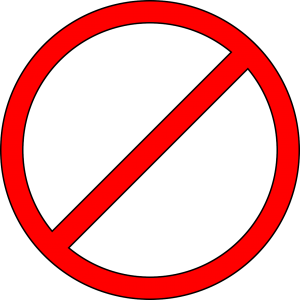
How Long Until a Dog Is Fully Potty Trained?
House training is a long process and many trainers say that a dog is only considered "fully potty trained" if the dog has gone more than a year without having an accident indoors. For some dogs, it can take upwards of two or three years to reach this point. But most dogs are reasonably well potty trained by 12 to 18 months. And larger breed dogs (80 lbs+) tend to pick up on potty training faster than smaller dogs.
If your puppy starts to have a higher number of accidents than before, take a step back in your potty training. Regression is common, so don't get discouraged if it happens. So if you'd been waiting four hours between potty breaks for your four-month-old puppy, then go back to three hours between breaks.
Potty training isn't a race and each puppy will be different. Be patient with your pup and with yourself and you'll get there in the end.
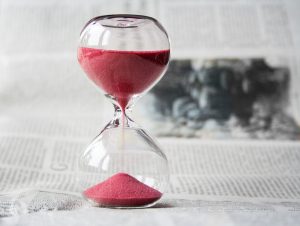
How to Potty Train a Puppy: 6 Steps
When housebreaking a puppy, follow these guidelines:
#1: Give your puppy a contained home space and a specific bathroom space.
#2: Use a cue word to indicate to your dog that it's time to potty.
#3: Set a clear potty training schedule.
#4: Use treats and positive reinforcement to encourage your dog's progress.
#5: Give your puppy a little free play time but not so much that their tempted to potty inside.
#6: Interrupt dogs who are going to the bathroom in the house, but don't punish them retroactively.
This guide covers all the basics of how to potty train a puppy, but don't hesitate to ask at your local pet store or doggy day care (or even dog park) if you have more questions!










